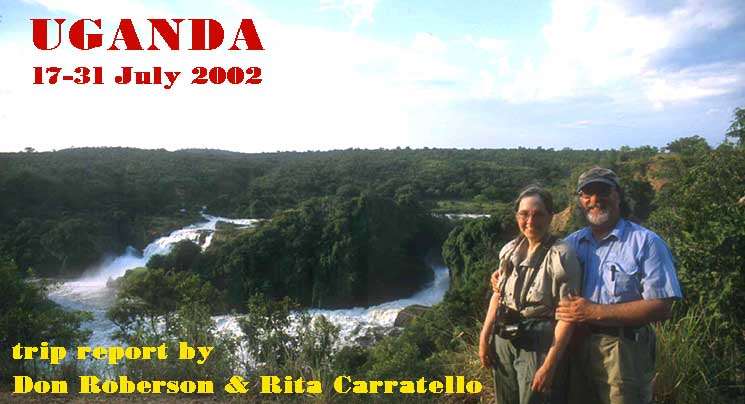

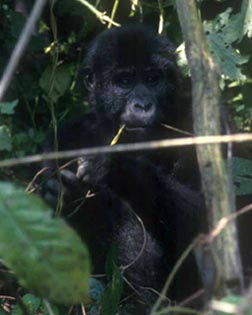
|
This is a report of a bird & mammal watching trip to Uganda,
now a safe and splendid destination for tourists. Highlights included:
|
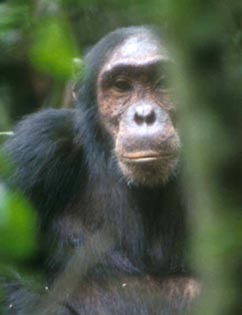
|
Uganda has been through troubled times in past decades with Idi Amin,
Milton Obote, and the murder of 8 gorilla tourists by Rwandan rebels at
Bwindi in March 1999. Today, however, it is a rebounding country. The economy
is booming while that in adjacent Kenya is in decay. The Ugandan army has
sealed the borders around Bwindi and armed escorts protect every tourist
going into the forest there. Insurgency near the Sudanese border in the
north (the Lord's Resistance Army) changed some of our routes in 2002,
but presented no dangers. The people throughout were friendly and helpful,
and prices were much less expensive than the well-traveled tourist routes
in Kenya and Tanzania. We had mostly pleasant accommodations (sometimes
luxurious) and good food throughout, although the road system (rough, bumpy
dirt in many places) left much to be desired. The parks were brimming with
birdlife. With a birdlist of over 1000 species in a country the size of
Great Britain, it is said to be the birdiest country in Africa.
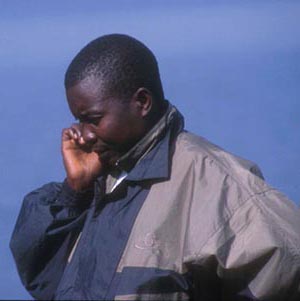 Upon the recommendation of Jon Hornbuckle, Rita & I engaged Hassan
Mutebi (right) as our guide/driver throughout. His company Access
Uganda Tours, run jointly with his fiancée Jaria, handled
all our arrangements splendidly. [Hassan's brother was leading another
group of birders for the company at the same time, and we overlapped briefly
with them at Queen Elizabeth II park.] Hassan is an active member of the
Uganda Bird Guides Club, and currently has the 3rd highest bird list for
the country. As he was confirming arrangements for us and other groups,
he seemed constantly on his cell phone (as in this shot) -- we were amazed
at the cellular phone coverage throughout the county (we don't have that
good of coverage in Monterey Co., U.S.A.!). He was a good driver and companion,
and knew the important bird sites. We also did some brief exploring of
thornscrub east of Masindi with good results. By hiring Hassan directly
as our driver/guide and having him make arrangements, the cost of the land
portion of our visit was less than half that charged by most bird tours
for similar length trips.
Upon the recommendation of Jon Hornbuckle, Rita & I engaged Hassan
Mutebi (right) as our guide/driver throughout. His company Access
Uganda Tours, run jointly with his fiancée Jaria, handled
all our arrangements splendidly. [Hassan's brother was leading another
group of birders for the company at the same time, and we overlapped briefly
with them at Queen Elizabeth II park.] Hassan is an active member of the
Uganda Bird Guides Club, and currently has the 3rd highest bird list for
the country. As he was confirming arrangements for us and other groups,
he seemed constantly on his cell phone (as in this shot) -- we were amazed
at the cellular phone coverage throughout the county (we don't have that
good of coverage in Monterey Co., U.S.A.!). He was a good driver and companion,
and knew the important bird sites. We also did some brief exploring of
thornscrub east of Masindi with good results. By hiring Hassan directly
as our driver/guide and having him make arrangements, the cost of the land
portion of our visit was less than half that charged by most bird tours
for similar length trips.
Our 15-day Uganda visit was part of a month-long
honeymoon adventure that was followed by almost two weeks in the game
reserves
of northern Tanzania (with our friends John & Elaine Sorensen) and
a brief transition stop at Mountain Lodge, Kenya. [Our United &
British
Air connections required that we fly out of Nairobi if we wanted to fly
directly into Entebbe, Uganda.] With Hassan's help, we designed an
itinerary
that maximized our chances to see Shoebill, Gorilla, and Chimpanzee
while
making a clockwise circuit of much of western and central Uganda. I
really
wanted to go for Uganda's only endemic bird — Fox's Weaver — and that
required
a full day (8 hours drive to and from Jinja). [We were taken to weaver
colony and told they were Fox's; we only learned a decade later that
they were not.] We also wanted two days at
higher elevations in the Bwindi-Impenetrable Forest to search for
Albertine
Rift endemics, and we wanted to visit Lake Mburo in hopes of the
finfoot
and other specialties. Hitting all these hot spots in just 15 days
meant
a lot of driving, and comparatively little time at each locale. We
could
easily have used more days at Bwindi, Queen Elizabeth, and Murchison
Falls
parks. We also had to cut out the Budongo Forest entirely (it is on the
"usual" route of most bird tours) to accommodate a Fox's Weaver
attempt.
As Rita & I had birded Gabon [see our Gabon
trip report], and many lowland forest species of the Congo Basin are
shared between Budongo and Gabon, this seemed the site most easily deleted
(but we did thus miss a number of birds oft-found by tours, such as Puvel's
Illadopsis).
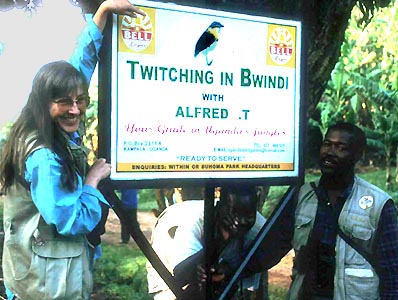 At the prime spots, Hassan hired local experts as our birding guides. The
best bird guide in Uganda is Alfred Twinomujuni, a former school teacher
who now is a professional bird-leader fulltime (left is Alfred's
sign at his house at Buhoma, with Rita, Hassan, and Alfred, left to right).
He particularly specializes in birding at Bwind-Impenetrable Forest. He
knows all the calls and has tapes of the endemics and more to call in the
many secretive undergrowth or canopy species. Because he is often pre-booked
by organized bird tours, we sought to book him long in advance. We had
to change our itinerary to book him for our 4 days in Bwindi, thus retracing
our steps to Mburo rather than stopping there enroute from Entebbe (the
international airport) and Bwindi. Even at that, he was unaccountably double-booked
our final day and did not have him as our guide at Buhoma — this was a
costly loss for us in terms of birds missed. At Kibale Forest we had the
excellent Ronald, at Mabira forest Ibraham, at Bigodi Swamp it was Jose,
and the fill-in for Alfred at Buhoma was Levi.
At the prime spots, Hassan hired local experts as our birding guides. The
best bird guide in Uganda is Alfred Twinomujuni, a former school teacher
who now is a professional bird-leader fulltime (left is Alfred's
sign at his house at Buhoma, with Rita, Hassan, and Alfred, left to right).
He particularly specializes in birding at Bwind-Impenetrable Forest. He
knows all the calls and has tapes of the endemics and more to call in the
many secretive undergrowth or canopy species. Because he is often pre-booked
by organized bird tours, we sought to book him long in advance. We had
to change our itinerary to book him for our 4 days in Bwindi, thus retracing
our steps to Mburo rather than stopping there enroute from Entebbe (the
international airport) and Bwindi. Even at that, he was unaccountably double-booked
our final day and did not have him as our guide at Buhoma — this was a
costly loss for us in terms of birds missed. At Kibale Forest we had the
excellent Ronald, at Mabira forest Ibraham, at Bigodi Swamp it was Jose,
and the fill-in for Alfred at Buhoma was Levi.
One must also book the gorilla trekking long in
advance to get the day of your choice. It costs $275 per person for the
gorilla tracking day with guides, guards, and trackers, plus another $10
or so if you want a porter for your gear. We had hoped a third birder might
join us so pre-paid for 3 spots for gorilla tracking; unfortunately, we
were unable to resell our extra permit. In fact, although the park takes
groups of six to the gorillas daily, the four other tourists who happened
to reserve spots on our day didn't show up, leaving just Rita & I do
go tracking the Mubare group. This was fabulous for us as we could go at
our own pace and enjoy our hour with the gorillas without competing for
viewing spots with anyone else!
A brief list of our itinery
follows, and a map with a key to the
overnight stays on each of our 15 days:
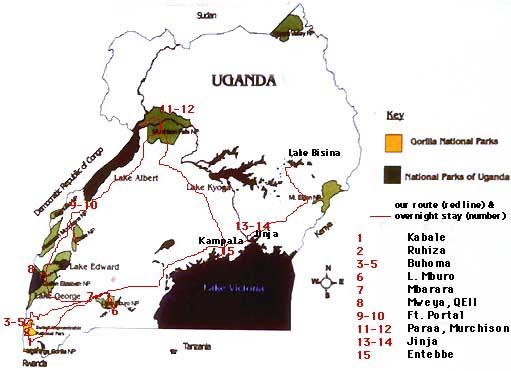
Rita & I had previously been to Gabon and South Africa (and I had
been to Kenya), so we focused our efforts on specific birds and families,
rather than attempt a big number with lots of common and widespread species.
It would have been nice to share the experience with one or two others
of similar temperament, but we had a great time. Other world birders (and
certainly those visiting Africa for the first time) may wish to set a more
hectic pace and get a higher species total. For those, bird tours are good
(Rockjumper Tours out
of South Africa or Birdquest
out of England are good) or you can spend more time and visit more places.
Jon Hornbuckle's 17-day trip in July 2001 was excellent. They added Budongo
Forest and Mgahinga National Park that we did not do; see his trip
report on-line on Worldtwitch.
Others add a visit to Semliki Forest.
As this was a trip undertaken by just Rita and me,
we were able to structure each day as we wished. This generally meant very
early breakfast (almost every place we stayed was accommodating to this
request — a real contrast to more touristy places!), serious morning and
afternoon birding or game drives, but a nice lunch and an early (e.g.,
6 or 7 pm) dinner most days. We almost always got a nice 8 hours sleep
— another key difference from a the more hectic pace of a serious bird
tour. We had time to photograph when we wished, and time to concentrate
on the species we wanted. On the other hand, our ~390 species in 15 days
is about 100 species less than a hardcore bird tour with a professional
leader; e.g., the 12-day Birdquest tour that our friend Steve Bailey took
in August 2002 — Steve personally saw 488 birds). [And bird tours get even
more species in the northern winter when Eurasian migrants are in abundance.]
Yet in comparing our bird list to Steve's list, we saw about the same number
of "critical lifers" (species for which a Uganda trip is crucial) and even
more Albertine Rift endemics than did his trip. We got Brown-chested
Lapwing, and Toro Olive Greenbul; he got Kivu Ground-Thrush, Red-chested
Owlet, and Hartlaub's Marsh Widowbird. We both tried for and missed African
Green Broadbill, Green-breasted Pitta. and Fox's Weaver; only the very fortunate find
these specialties. I was particularly pleased, however, with my photographic
opportunities during our quick-paced trip. With the help of Alfred, or
Rita, or Hassan playing tapes, I was able to photograph, for example, these
four usually secretive bush-shrikes:
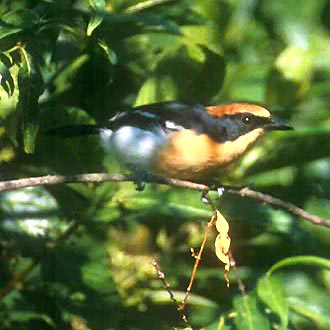 |
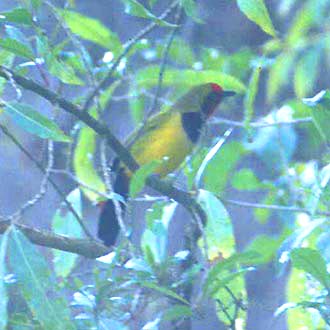 |
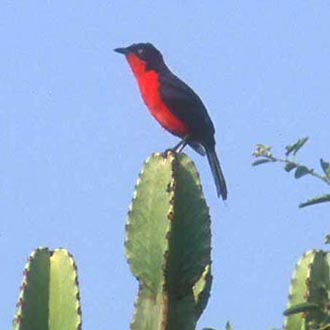 |
 |
We went in July to avoid the rainy season (mostly
Nov-Apr, but sometimes into June and as early as Sept), but Alfred tells
us that this choice handicapped us in terms of birdsong and responsiveness.
We had to work hard with tapes for almost every Albertine Rift specialty
— in April-June and again Sept-Oct, these birds are much more responsive
and readily seen. We missed all the crimsonwings (4 species in the Rwenzoris);
Alfred says all 4 had been rather easily found in May. The African Green
Broadbill is nesting then. We had some afternoon showers in the mountains
and a morning of rain at Mabira — even in the "dry" season — so our concerns
about rain in other months may have been overdone. Indeed, my Swedish friend
Stefan Lagerblad led a trip (with Hassan as his driver) in January 2002
that recorded 579 species in 20 days. One good thing about July, however,
is that most weavers and widowbirds were still in breeding dress. By the
time we got to Tanzania in August, most weavers there had molted into basic
plumage. My prior trip to Kenya in November, and Lagerblad's trip to Uganda
in January, were all at times when one struggles with non-breeding-plumaged
weavers.
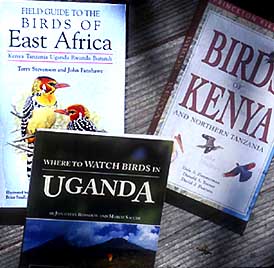 Birders are very fortunate these days to have an outstanding bird-finding
guide to Uganda (Rossouw & Sacchi 1998) and two fabulous field guides
(Stevenson & Fanshawe 2002, Zimmerman et al. 1996). The Birds of
East Africa by Terry Stevenson & John Fanshawe is the guide of
choice for Uganda. It includes all the birds of that country; it has good
maps and text facing each page of plates; and the 3 artists did an excellent
job of capturing most species accurately. It is one of the best field guides
in the world. The Zimmerman et al. Guide to Kenya and Northern Tanzania
covers 85% of Uganda's birds but does not have the Albertine Rift endemics
or northern Uganda specialties, so one does not use it much in the west
or north. But it is very good for the Kampala area; its maps are better
as they show seasonality (although the maps are inconveniently located
in the text in the back of the book); the text is more extensive; and some
of the plates (e.g., raptors) were a bit better. Jonathan Rossouw and Marco
Sacchi"s Where to Watch Birds in Uganda — absolutely filled with
gorgeous photos, maps, and complete lists for every bird site — is one
of the best bird-finding efforts in the whole world. Finally, for problems
with specific birds, I reviewed the text and art in the Birds of Africa
series, especially for greenbuls (Keith et al. 1992) and sunbirds (Fry
et al. 2000). And I enjoyed Harris (2000) on bush-shrikes and batises.
Birders are very fortunate these days to have an outstanding bird-finding
guide to Uganda (Rossouw & Sacchi 1998) and two fabulous field guides
(Stevenson & Fanshawe 2002, Zimmerman et al. 1996). The Birds of
East Africa by Terry Stevenson & John Fanshawe is the guide of
choice for Uganda. It includes all the birds of that country; it has good
maps and text facing each page of plates; and the 3 artists did an excellent
job of capturing most species accurately. It is one of the best field guides
in the world. The Zimmerman et al. Guide to Kenya and Northern Tanzania
covers 85% of Uganda's birds but does not have the Albertine Rift endemics
or northern Uganda specialties, so one does not use it much in the west
or north. But it is very good for the Kampala area; its maps are better
as they show seasonality (although the maps are inconveniently located
in the text in the back of the book); the text is more extensive; and some
of the plates (e.g., raptors) were a bit better. Jonathan Rossouw and Marco
Sacchi"s Where to Watch Birds in Uganda — absolutely filled with
gorgeous photos, maps, and complete lists for every bird site — is one
of the best bird-finding efforts in the whole world. Finally, for problems
with specific birds, I reviewed the text and art in the Birds of Africa
series, especially for greenbuls (Keith et al. 1992) and sunbirds (Fry
et al. 2000). And I enjoyed Harris (2000) on bush-shrikes and batises.
Tapes are very important in the Uganda forests.
Alfred had his own set that we used extensively at Ruhiza. I had bought
a new mini-disc recorder and a high-end Sennheiser shotgun microphone.
These proved invaluable in seeing papyrus specialties and in forest birding,
although I was not yet proficient in the use of this new equipment. We
had Jonathan Rossouw's Bird Calls of the Uganda Forest with its
83 species, almost all specialty birds of the forest and including almost
all the endemics; it is a highly recommended tape available through Rockjumper
Tours. I had also transcribed some recordings from Keith & Gunn's
(1971)
Birds Sounds of the African Rain Forest phonograph record.
Despite these resources, many birds were simply not responsive in July.
This is just after the breeding season for many of them.
Adding to these resources, we found very helpful
trip reports on-line. I've mentioned Jon Hornbuckle's and Stefan Lagerblad's
trips above, but also useful were Henk Hendriks' and Alan Wilkinson's reports
from the early 1990s; Giles Mulholland's report from June-July 2001; and
notes from Richard Thomas who had visited in June 2002. Hornbuckle, Thomas,
Mulholland, and Rossouw all answered pre-trip questions via email, and
we are very grateful for all that assistance.
The links below go to pages with a detailed daily
log and a complete trip list. Each page includes many photographs.
|
DAILY LOG of the July 2002 TRIP |
|
covering both birds & mammals |
PHOTOS: All photos on this page are © 2002 Don Roberson; all rights reserved. Many other shots from this trip are scattered about the web site. Check particularly bird families, mammals, and herps listings.
Literature cited:
Fry, C., S. Keith, and E.M. Urban. 2000. The Birds of Africa. Vol. VI. Academic Press, London.TOPHarris, T. 2000. Shrikes and Bush-Shrikes. Princeton Univ. Press, Princeton, N.J.
Keith, S., E.M. Urban, and C. Fry. 1992. The Birds of Africa. Vol. IV. Academic Press, London.
Rossouw, J., and M. Sacchi. 1998. Where to Watch Birds in Uganda. Uganda Tourist Board, Kampala.
Stevenson, T., and J. Fanshawe. 2002. Field Guide to the Birds of East Africa. T. & A.D. Poyser, London.
Zimmerman, D.A., D.A. Turner, and D.J. Pearson. 1996. Birds of Kenya and Northern Tanzania. Christopher Helm, London.
GO TO LIST OF BIRD FAMILIES OF THE WORLD
Page created 1-2 Sep 2002, slightly updated 10 Sep 2011